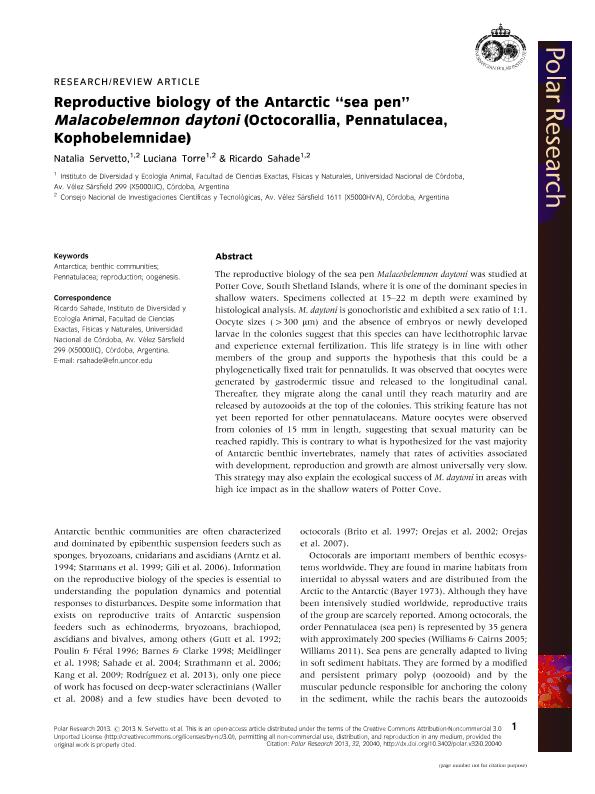Artículo
Reproductive biology of the Antarctic "sea pen" Malacobelemnon daytoni (Octocoralia, Pennatulacea, Kophbelemnidae)
Fecha de publicación:
07/2013
Editorial:
Norwegian Polar Institute
Revista:
Polar Research
ISSN:
1751-8369
Idioma:
Inglés
Tipo de recurso:
Artículo publicado
Clasificación temática:
Resumen
The reproductive biology of the sea pen Malacobelemnon daytoni was studied at Potter Cove, South Shetland Islands, where it is one of the dominant species in shallow waters. Specimens collected at 1522 m depth were examined by histological analysis. M. daytoni is gonochoristic and exhibited a sex ratio of 1:1. Oocyte sizes (300 mm) and the absence of embryos or newly developed larvae in the colonies suggest that this species can have lecithotrophic larvae and experience external fertilization. This life strategy is in line with other members of the group and supports the hypothesis that this could be a phylogenetically fixed trait for pennatulids. It was observed that oocytes were<br />generated by gastrodermic tissue and released to the longitudinal canal. Thereafter, they migrate along the canal until they reach maturity and are released by autozooids at the top of the colonies. This striking feature has not yet been reported for other pennatulaceans. Mature oocytes were observed from colonies of 15 mm in length, suggesting that sexual maturity can be reached rapidly. This is contrary to what is hypothesized for the vast majority of Antarctic benthic invertebrates, namely that rates of activities associated with development, reproduction and growth are almost universally very slow. This strategy may also explain the ecological success of M. daytoni in areas with high ice impact as in the shallow waters of Potter Cove.
Palabras clave:
Antarctica
,
Benthic Community
,
Pennatulacea
,
Reproduction
,
Oogenesis
Archivos asociados
Licencia
Identificadores
Colecciones
Articulos(IDEA)
Articulos de INSTITUTO DE DIVERSIDAD Y ECOLOGIA ANIMAL
Articulos de INSTITUTO DE DIVERSIDAD Y ECOLOGIA ANIMAL
Citación
Sahade, Ricardo Jose; Servetto, Natalia; Torre, Luciana; Reproductive biology of the Antarctic "sea pen" Malacobelemnon daytoni (Octocoralia, Pennatulacea, Kophbelemnidae); Norwegian Polar Institute; Polar Research; 32; 7-2013; 1-11
Compartir




